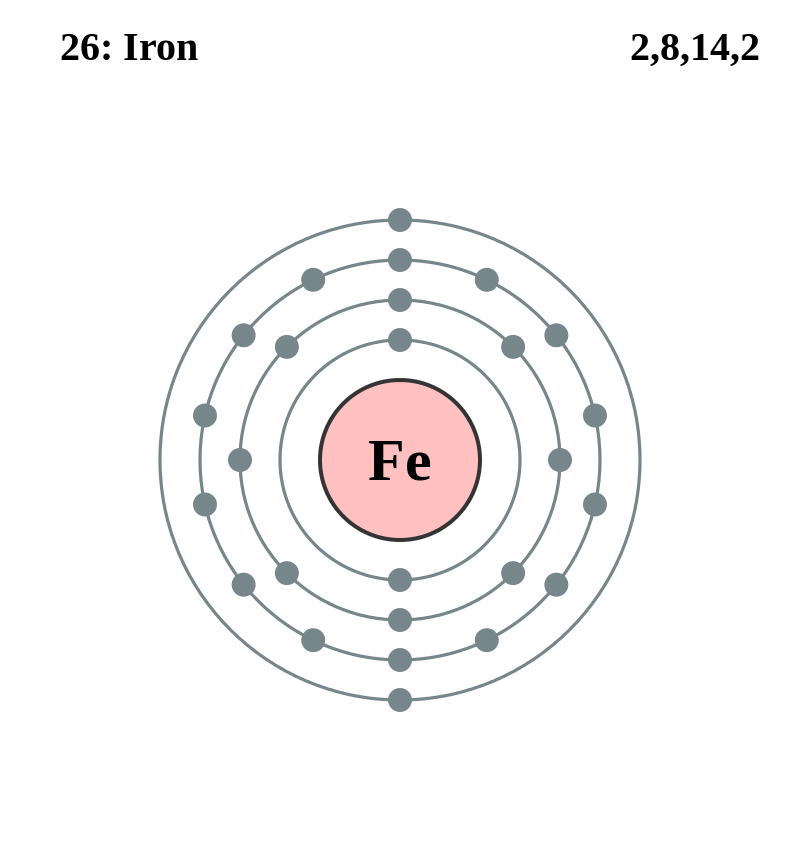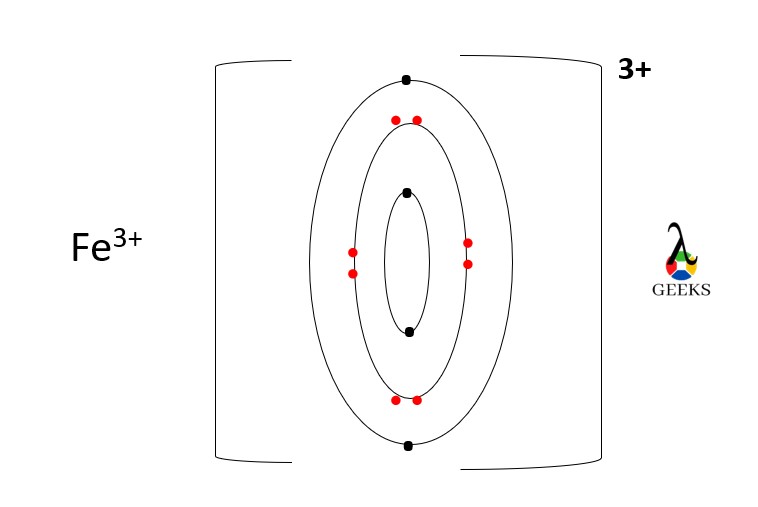In this article we will discuss about the Fe3+ Lewis structure , characteristics 15 facts we should know.
A Ferric ion or Fe3+ is a trivalent metal cation and a monoatomic trication. It is the oxidized form of iron (Fe) metal.
How to draw Fe3+Lewis structure ?
While drawing the Lewis structure of any molecule or ion the number of electrons that take part in bond formation plays an important role. In order to draw the Lewis structure of an ion or molecule, the number of valence electrons is considered for the Lewis dot structure and other electrons which participate in bond formation also play an important in Fe3+ Lewis structure.
When three electrons are lost from an iron atom it forms a ferric ion or Fe3+. The electronic configuration is as follows,
Fe = 1s2 2s2 2p6 3s2 3p6 3d6 4s2. and Fe3+ = 1s2 2s2 2p63s2 3p6 3d5


Fe3+ Lewis structure resonance
Ferric ion (Fe3+) has only one resonating structure is same as that of its Lewis structure. because ferric ion (Fe3+) does not contribute in delocalization of electrons or delocalization of double bonds in its chemical structure . Hence (ferric ion) Fe3+ Lewis structure shows only one resonance structure.

Fe3+ Lewis structure shape
Ferric ion (Fe3+) does not undergo any hybridization as it is in the ionic form, it does not show any specific shape. When it is combined with another metal or undergoes complex ion formation then it shows some shape according to its hybridization.
Fe3+ Lewis structure formal charge
In the (Ferric ion) Fe3+ Lewis structure number of actual charges corresponds to total formal charges. The formal charges are calculated by the Fe3+ Lewis structure which is calculated by the following formula,
The formal charge on Fe3+ ion = valence electron of Fe3+ – lone pair of Fe3+ -1/2 (bond pair of electrons)
According to the formal charge calculation formula, Fe3+is not a molecule and it’s an ion. It doesn’t take part in any chemical bond hence it has no formal charges on itself.
Fe3+ Lewis structure angle
The bond angle is the angle which is formed by the bonds present in the molecule, In (Ferric ion) Fe3+ Lewis structure does not show a bond angle, because it is an ion which does not form a bond in them when this ferric ion forms any molecule or complex then it shows some bond angle.
Fe3+ Lewis structure octet rule
In the case of the Fe3+ ion, its octet is fulfilled. When a ferric ion loses three electrons then its outermost shell completes its octet and becomes stable. The outermost electronic configuration of Fe is [Ar] 3d6 4s2 and Fe3+ is [Ar] 3d5 so Fe 3+ is stable by completing its octet.
Fe3+ lewis structure lone pairs
Lone pair of electrons are those pair of electrons which does not take part in a chemical reaction , The lone pair of an electron in an atom can be calculated by subtracting no. of electrons shared by the atom from the valence electrons and divided by two. There is no lone pair of electrons in the Fe3+ Lewis structure.
Fe3+ valence electrons
Valence electrons are the electrons which are present in the outermost orbital of an atom, ion or molecule. These valence electrons take part in chemical bond formation. In ferric ion (Fe3+) outermost shell contains 5 valence electrons that is Fe3+ = [Ar] 5d5
Fe3+ hybridization
Hybridization is a process in which the atomic orbital of molecules combines to form a new hybrid orbital. In ferric ion, it does not have atomic orbitals hence it does not undergo Since Fe3+ is an ionic compound. So Fe3+ Lewis structure does not show any hybridization.
Fe3+ solubility
Generally, the salt of Fe+3 is insoluble and Fe+2 soluble because Fe+3 salt is more covalent in nature than Fe+2 salt. covalent compounds are more soluble than ionic compounds.
Is Fe3+ acidic or basic ?
A compound or an ionic species has a capacity to accept an electron which means the compound or an ion has a vacant orbital in their outermost orbital. Electron configuration for Fe3+ is 1s2 2s2 2p6 3s2 3p6 4s0 3d5. Here Fe3+ ion has 4s and 5d vacant orbital so the ferric ion can accept three electrons for completing its outermost shell It makes Fe3+ Acidic in nature.
Is Fe3+ polar or nonpolar ?
If the molecule is symmetrical or unsymmetrical structure the charge distribution among themselves is uneven or even, so their dipole moments become zero or non-zero. A Ferric ion is an ionic compound so we cannot determine the polarity of that Fe3+ ion.
Is Fe3+ a lewis acid or base ?
A compound or an ionic species has a capacity to accept an electron which means the compound or an ion has a vacant orbital in their outermost orbital. Electron configuration for Fe3+ is 1s2 2s2 2p6 3s2 3p6 4s0 3d5. Here Fe3+ ion has 4s and 5d vacant orbital so the ferric ion can accept three electrons for completing its outermost shell It makes Fe3+ a Lewis Acid.
Is Fe3+ paramagnetic or diamagnetic ?
Ferric ion (Fe3+) shows paramagnetic nature . because ferric ion contain more unpaired electrons which are 5 in number hence it is weekly attracted by external magnetic field and form internal induced magnetic field in opposite direction.
while ferrous ion (Fe2+) contain less unpaired electrons hence less paramagnetic in nature. Also those atoms , ions or molecule which contain lone pair electrons or vacant outermost orbital has a paramagnetic in nature while those atom, ion or molecule contain all paired electrons are diamagnetic in nature .
Is Fe3+ reduced or oxidized ?
Ferric ions (Fe3+) is the oxidized form of iron (Fe). When the element or atom loses or gain its electrons and form a reduced or oxidized form of an element or an atom. Iron oxidizes to ferric ions. When iron loses three electrons from its outermost orbital it forms a ferric ion (Fe3+).
Conclusion
In the above article we will discuss the Lewis structure of Fe3+ ion also we will discuss the Lewis structure shape, hybridization, bond angle , lone pair , valence electrons , paramagnetic nature, Lewis acid property , oxidation property, non polar nature , solubility octet rule of ferric ion (Fe3+).
Also Read:
- Ibr lewis structure
- Caf2 lewis structure
- Io4 lewis structure
- Ibr4 lewis structure
- Nh4cl lewis structure
- Bf3 lewis structure
- Propanoic acid lewis structure
- Pcl5 lewis structure 2
- If6 lewis structure
- Hgbr2 lewis structure

Hi….I am Darshana Fendarkar, I have completed my Ph.D. from the University of Nagpur. My area of specialization is Inorganic Chemistry.
I have an experience as a Chemist at Earthcare Pvt. Ltd. Also I have 2 years of experience in teaching. Currently, I am working with Lambdageek as a Subject Matter Expert.